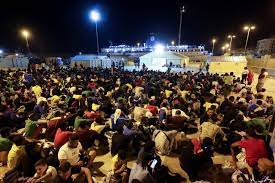‘A predictable failure’: New report examines shelter system in Italy

Rome: A new report by ActionAid and Openpolis highlights administrative problems and a surge in direct procurement in Italy’s emergency reception system, indicating a lack of transparency and efficiency in the system. The Meloni government’s migration policies are criticized for institutionalizing practices that violate the rights of migrants and minors.
The Emergency Reception Centers (CAS) make up 60 percent of the national shelter system, “characterized by administrative chaos, unanswered and repeated tenders, and a significant increase in direct procurement, rising from 35 percent in 2020 to 66 percent in 2023, resulting in contracts totaling 83.1 million euros in the first eight months of 2023 alone at the expense of transparency.”
These findings are detailed in a new report titled “A Predictable Failure: Centers in Italy 2023” by ActionAid and Openpolis.
In a press release dated March 18, ActionAid indicated that “A return to the problems found following the Security Decree of March 2018 but without any emergency concerning the migrant arrivals: according to Interior Ministry data, the number of sheltered individuals never exceeded 141 thousand in 2023 (0.18 percent of the Italian population). Moreover, these figures remained consistent with the previous year, with only 20-30 thousand new places created at CAS centers in 2023.
The migration decrees of the Meloni government and the declaration of a “State of Emergency” have institutionalized illegitimate practices that violate the rights of individuals and minors, effectively transforming emergency measures into new laws, the press release stated.
“A year later, regulations governing services and costs remain absent, resulting in arbitrary actions by prefectures.”
Also read: Italian bishops criticize government’s state of emergency declaration
ActionAid criticized the “over-proliferation of migration laws” under the Meloni government, which continues to introduce minor changes (six in the last 12 months) through decrees addressing various issues.
“To allow minors to be held in CAS adult centers makes the task easier for the local government offices, but it certainly is not in the interest of the minor,” stated Fabrizio Coresi, Migration expert for ActionAid.
“At the same time, concentrating persons in increasingly crammed centers helps prefectures to find places, but not complying with space issues seriously imperils the sanitary and security standards of those who are being sheltered. All these existing practices were tolerated as exceptions,” noted Coresi.
ActionAid underscored that the work needed to compile the report was drawn from data provided by the Italian Interior Ministry, also using the data of the National Anti-Corruption Authority (ANAC), analyzing 3,195 tenders for shelter center management (nearly 50 percent of the total 7,230 tenders) issued by Prefectures between 2020 and 2023.
The report also revealed that SAI centers (shelter and integration system), under the jurisdiction of local institutions and exclusively for refugees, accounted for 36.7 percent of the total 121 thousand places in 2022, with the remaining distributed among CAS (59.7 percent) and Initial Reception Centers (3.6 percent), which increased their maximum capacity from 266 to 335 places.
The majority of individuals are housed in the South (31.9 percent), but in terms of refugees’ incidence relative to the resident population, the North-East contributes the most (0.21 percent). However, SAI centers are more limited in this region, particularly in Friuli-Venezia Giulia.
ActionAid highlighted the issue of unanswered and repeated tenders, stating, “Between 2020 and 2022, nearly one-fifth of tenders and framework agreements remained unanswered. When Prefectures cannot assign places due to lack of participation, they resort to repetition. In 2022 and 2023, almost half of framework agreements were repeated, with 35 tenders repeated in the first eight months of 2023, surpassing the total number in 2020. This results in increased costs for widespread reception, with 53 percent of all such tenders remaining unanswered.”





